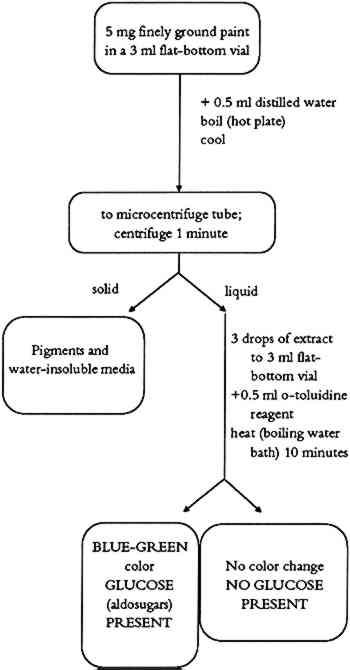BINDING MEDIA IDENTIFICATION IN PAINTED ETHNOGRAPHIC OBJECTSDUSAN STULIK, & HENRY FLORSHEIM
3 TESTS FOR CARBOHYDRATESComplex carbohydrates, (polysaccharides such as gums) and simple sugars (monosaccharides such as honey) have been used as binding media in ethnographic objects. In the past, the term “gums” was used as a general term to denote a Honey is the sweet, sticky material made from flower nectar by certain bees. Honey absorbs and retains moisture, thus retarding drying. Honey was used as a plasticizer to improve elasticity of other binding media (glues, or gums) or as a straight binding medium in certain ethnographic objects. All types of honey are rich in the simple sugars dextrose (D-glucose) and levulose (D-fructose). Detection of carbohydrates in paint samples is based on a sugar-specific chemical reaction. 3.1 TEST FOR SIMPLE SUGARS3.1.1 MethodSimple sugars are extracted from the sample using hot water. Upon heating, o-toluidine reacts with aldosugars (glucose) in the presence of acid to form a blue-green colored complex. 3.1.2 ProcedureThe simple sugar test flow chart is shown in figure 2. About 5 mg of finely ground paint sample or residue from the methylene chloride extraction (triglyceride test) is mixed with 0.5 ml of distilled water in a 3 ml flat-bottom vial. The resulting suspension is boiled for a short time on a hot plate at a low heat setting. After cooling to room temperature, the suspension is transferred to a microcentrifuge tube. After about 1 minute of centrifugation, 3 drops of supernatant are mixed in a 3 ml flat-bottom vial with 0.5 ml of o-toluidine reagent. The vial is placed in a boiling water bath for about 10 minutes. A positive test for simple sugars is indicated by the formation of a blue-green color (Hultman 1959; Hyvarinen and Nikkila 1962).
3.1.3 CommentsThis procedure tests for simple sugars (honey) as either a binding medium or a binding medium additive in paint samples. In the case of a very weak positive test, it is important to search for other binding media. Some complex binding media (milk, blood, egg, or plant juices) might contain enough carbohydrates to produce a weak positive test. In such cases, a combination of simple tests or the use of instrumental methods may be necessary. Some pigments (charcoal) were found to interfere with the test. Hence, the sample for the simple carbohydrate test should be obtained from nonblack paint layers of the object to avoid such a problem. 3.2 COMPLEX CARBOHYDRATE (GUM) TEST3.2.1 MethodThis method is identical to the test for simple carbohydrates with the addition of acid hydrolysis of the polysaccharide chains. 3.2.2 ProcedureThe complex carbohydrate test flow chart is shown in figure 3. About 5 mg of finely ground paint sample is mixed with 0.5 ml of 0.5 M H2SO4 in a 3 ml screw-cap vial. The vial is closed tightly and placed in an electric oven preheated to 100�C for 2 hours. The vial is removed from the oven, and allowed to cool to room temperature. The contents of the vial are transferred to a microcentrifuge tube and centrifuged 1 minute. Three drops of the supernatant are placed in a 3 ml flat-bottom vial. One drop of 6N NH4OH is added, followed by 0.5 ml of o-toluidine reagent. The vial is placed in a boiling water bath for about 10 minutes. A positive test is indicated by the formation of a blue-green color.
3.2.3 CommentsThis test identifies complex carbohydrates (natural plant gums) in paint samples. Battery black (impure manganese dioxide), yellow, and red ochres were found to interfere, giving a negative test. Samples containing different pigments (preferably white pigments) should be obtained for the complex carbohydrate test. |

